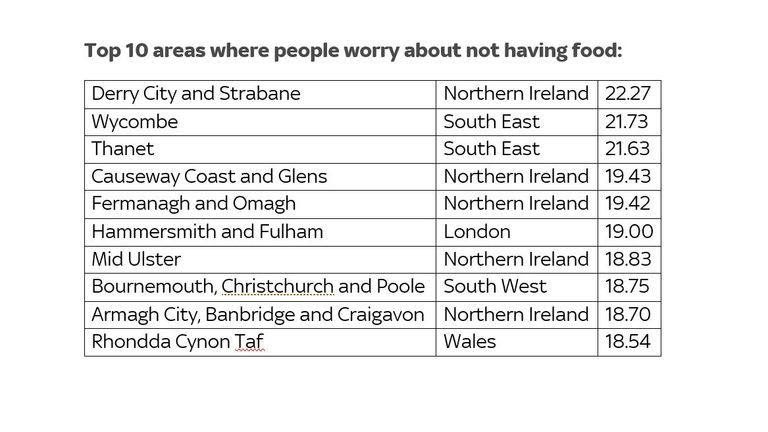Thousands of people in the UK struggle to access food, new study finds
The study from the University of Sheffield highlighted the alarming levels of food poverty in the UK.
Thursday 22 July 2021 02:26, UK
The rate of hunger is 150% higher than the national average in one out of every six local authorities in the UK, a new study has found.
The study from the University of Sheffield and the Food Foundation found the area worst hit by food insecurity is Wycombe, Buckinghamshire with 14% of people estimated to be hungry and nearly 30% of people struggling to access food.
This is followed closely by Hull in Yorkshire, where 13% of people said they are going hungry and more than one in five adults struggling to access food.
The area with the least hunger, struggle or worry is St. Albans.
Researchers modelled data from the Food Foundation, which used a YouGov survey that identified which local authorities are most affected by hunger in the UK.
According to the data, in January 2021, 4.2% of adults reported that during the previous month they had been hungry but unable to eat at least once.
The majority of areas in Yorkshire and the Humber are in the top 20 percentile with the greatest percentages of adults going hungry, whereas, in the east of England, the majority of authorities are in the 20% that have the lowest levels of hunger.
Food insecurity is the inability to consistently afford and access food needed to maintain good health and wellbeing.
The problem has been highlighted recently due to the rise in reporting on food bank usage in the UK. In November 2020 The Trussell Trust saw a 47% increase in support needed during the pandemic.
Dr Megan Blake from the University of Sheffield Institute for Sustainable Food, who collaborated on the work, said: "While no one should have to go hungry, struggle to get or worry about having enough food, in some places, it is at proportions that are especially shocking, particularly as we are a wealthy country."
This new analysis of the data shows how not everyone living with food insecurity experiences hunger on the same level, making it apparent that a large number of people actively plan to go without food to make ends meet.
For some people, living on the edge of food insecurity may mean an unexpected event such as a car or boiler breakdown or an unexpected illness, could be the tipping point that squeezes food budgets.
This in turn can be linked to higher rates of illness and obesity due to people buying cheaper foods, which store longer and are more filling, over healthier choices.
Anna Taylor, Executive Director, Food Foundation said: "COVID-19 has pushed households across the UK further into hardship and forced a newly vulnerable segment of society to seek help for the first time."
The data from Food Foundation is from an online survey of 4,231 adults in the UK conducted on 29 January - 2 February 2021 by YouGov.








